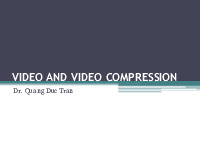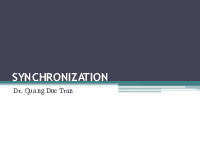



















Preview text:
RTP, RTCP & RTSP Dr. Quang Duc Tran Multimedia Traffic The production, transmission, The production, transmission, and use of data take place at and use of data take place at the same time different times Real-time Real-time Multimedia Traffic Multimedia Traffic Traffic Streaming Live A/V
(Broadcast TV/radio via Internet)
Can not pause, rewind. The time between Streaming Stored A/V
request and display is from 1 to 10 (Like VoD) seconds.
May pause, rewind… The time between
Real-Time Interactive A/V
request and display is from 1 to 10 (IP Phone, Video conferencing) seconds.
Can not pause, rewind. The time between request and display is small
(video<150 ms and audio<400 ms)
Real-Time Multimedia Traffic Server Client Server Client
Jitter: The gap between received packets 0s 0s
Note that delay is not constant 1s 1s 10s 10s 7s 11s 20s 20s 21s 15s 30s 30s 31s 27s 37s
• The use of timestamps may overcome the jitter problem. Each
packet has a time of the packet with respect to the first packet.
• The playback is delayed 7s after receiving the first packet.
• Playback buffer is needed to separate playback time from the arrival time. Playback Point • D = ED + β EV Where ▫ D: Playback Point
▫ ED: Estimated average packet delay
▫ EV: Estimated average packet delay variation ▫ β: Safety Factor (β=4)
• EDi = α EDi-1 + (1 - α) (ri - ti)
• EVi = α EVi-1 + (1 - α) (ri - ti - EDi) Where
▫ α: Weighting Factor (α=0.998)
▫ ri : Time the packet i is received
▫ ti : Timestamp of the packet i
Why Real-Time Data Can Not Be TCP?
• TCP forces the sink application to wait for
retransmission(s) in the case of packet loss, causing large delays.
• TCP cannot support multicast, which is a basic
requirement of video conferencing applications.
• TCP congestion control mechanisms decreases the
congestion window when packet losses are detected.
Audio and video on the other hand have bitrates that cannot be suddenly decreased.
Why Real-Time Data Can Not Be TCP?
• TCP headers are larger than a UDP header.
• TCP does not contain the timestamp and encoding
parameters, needed by the receiver.
• TCP does not allow packet loss. In A/V, a loss of 1-20% is
tolerable. The loss can be compensated by FEC.
Multimedia Protocol Stack Synchronization Service Media encaps DASH (H.264, MPEG-4) SIP RTSP RSVP RTCP RTP HTTP TCP DCCP UDP IP Version 4, IP Version 6 AAL3/4 AAL5 MPLS ATM/Fiber Optics Ethernet/WIFI
Real-Time Transport Protocol
• RTP is a network protocol for delivering audio and video over
IP network. RTP is used in conjunction with the Real-Time
Control Protocol (RTCP). While RTP carries the media
streams, RTCP is used to monitor transmission statistics and
QoS and aids synchronization of multiple streams.
• RTP does not ensure real-time delivery, but it provide means for
▫ Jitter elimination/reduction by using playback buffer.
▫ Synchronization of several audio and video streams.
▫ Multiplexing of audio and video streams.
▫ Translation of audio and video streams.
Real-Time Transport Protocol Version Padding Bit Marker bit (1 – The Incremented for each Number (2) (1 – Packet frame boundary is RTP packets (it is used contains marked) to indicate packet loss padding) and packet sequence) Contr. Ver. P X M Payload Type Sequence Number Count Timestamp ID of the source that is
Synchronization Source Identifier generating the RTP Extension bit (1- packets Contributor Identifier Fixed header is followed by an It is used by a mixer to … extension header) identify the contributing Contributor Identifier sources UDP RTP Pad RTP Payload Padding Header Header Count
Timestamp and Sequence No. • Audio
▫ RTP packet caries 20 ms of audio samples. Timestamp clock rate
for audio is 8000 Hz. Hence, timestamp increments by 160.
▫ No. of bits per RTP payload for uncompressed audio is
160x8=1280. That for compressed audio is typically 8 times less. • Video
▫ RTP packet caries one video frame. RTP packet rate is 25 or 30
Hz. Timestamp clock rate for video is 90,000 Hz. Hence,
timestamp increments by 3600 or 3000.
▫ No. of bits per RTP payload for uncompressed video conferencing is 352x240x12 = 10000 Timestamp Clock Rate Clock Frame Packet Name Type Description References rate (Hz) size (ms) size (ms) PCMU Audio 8000 any 20 ITU-T G.711 PCM RFC 3551 GSM Audio 8000 20 20 European GSM 13 kbps RFC 3551 G722 Audio 8000 any 20 ITU-T G.722 64 kbps RFC 3551 L16 Audio 44100 any 20 Linear PCM 16 bit stereo RFC 3551 G729 Audio 8000 10 20 G.729, G.729a 8 kbps RFC 3551 raw Video 90000 Uncompressed video RFC 4175 RFC 3551 H.263 Video 90000 H.263, 1st-3rd version RFC 4629 RFC 2190 RFC 3984 H.264 Video 90000 H.264 AVC, H.264 SVC RFC 6190 JPEG Video 90000 JPEG2000 video RFC 5371
Real-Time Control Protocol
• RTCP provides out-of-band statistics (e.g., packet loss,
packet delay variation, round-trip delay time) and
control information for an RTP session.
• The functionalities of RTCP include:
▫ Gathering statistics on quality aspects of the media
distribution and transmitting this data to the session media
source and other session participant.
▫ Provisioning session control functions. RTCP is a
convenient means to reach all session participants. RTP is
only transmitted by a media source.
Real-Time Control Protocol (Cont.) UDP RTCP Packet RTCP Packet RTCP Packet Header RTCP RTCP Data Header Version P RR Count Packet Type Message Length Padding bit 200: SR (Sender Report) 201: RR (Receiver Report) Number of Reception 202: SDES (Source Description) Report Blocks, contained 203: BYE in the packet
204: APP (Application Specific Message) 207: XR (RTCP Extension)
Real-Time Control Protocol (Cont.) • Sender Report (SR)
▫ It is sent periodically by the active senders to report
transmission and reception statistics. The report include an
absolute timestamp, allowing the receiver to synchronize
RTP messages. (Note: video and audio streams use
independent relative timestamps). • Source Description (SDES)
▫ It is used to send CNAME item to session participant that
provides additional information such as the name, e-mail
address, telephone number of the owner of the source.
Real-Time Control Protocol (Cont.) • Receiver Report (RR)
▫ It informs the sender and other receivers about the QoS. • Goodbye (BYE)
▫ A source sends a BYE message to shut down a stream. It
also allow an endpoint to announce that it is leaving the conference.
• Application Specific Message (APP)
▫ The application-specific message provides a mechanism to
design application-specific extensions to the RTCP protocol.
Real-Time Control Protocol (Cont.)
• The volume of RTCP traffic may exceed the RTP traffic
during a conference session involving large number of
participants. This is because RTCP packets are sent
regardless whether participant is talking or not.
• RTCP traffic is dynamically changed depending of the
number of participants. Typically, it is designed to be no
more than 5% of the RTP traffic (1.25% allocated to
sender, and 3.75% allocated to receivers). As number of
receivers increases, frequency of response per receiver decreases.
Forward Error Correction D …. 1 D2 D3 DN-1 P1 FEC P1 = XOR(D1, D2,D3,…,DN-1) P1 is called Parity Packet D3 = XOR(D1, D2,…,DN-1,P1) D …. …. 1 D2 Dk P1 P2 PN-k
The Parity Packets can help to recover the loss of any N-k
out of N packets (Reed Solomon Erasure Code).
FEC increases the required bandwidth and latency. Interleaving 1 2 3 4 5 6 7 8 9 10 11 12 13 14 15 16
Original RTP packets, each contains 20 ms of voice samples 1 5 9 13 2 6 10 14 3 7 11 15 4 8 12 16 1 2 4 5 6 8 9 10 12 13 14 16
Lost packet causes 5 ms gaps in the audio stream, which
can not be noticed. Interleaving does not increase the
bandwidth, but increases delays. Receiver-Based Repair 1 2 3 4 1 2 3 4
Receiver-Based Repair does not increase the bandwidth
requirement nor delays. It works with small packets and is
based on the assumption that there is a small difference
between two neighboring packets (voice packets).
Packet is recovered by interpolation, which can be
computationally expensive and small delay.
Real-Time Streaming Protocol
• RTSP is a network control protocol (port number is 554),
designed for controlling streaming media servers. It is
used to establish and control media session between
end-points. Most RTSP servers use the RTP and RTCP for media stream delivery.
• Similarly to HTTP, RTSP defines control sequences
useful in controlling multimedia playback and uses TCP
to maintain end-to-end connection. Unlike HTTP, RTSP
has state. Request can be made by both the streaming server and client.




